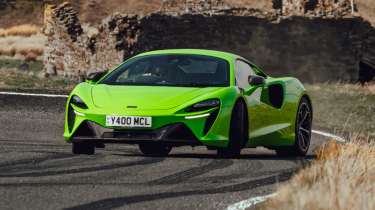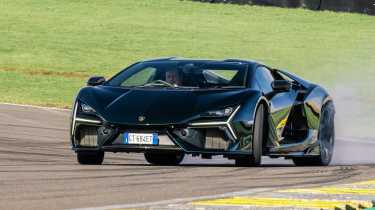Best hybrid cars 2025 – electrified cars that're higher on performance and lower on tax
Hybrids are the perfect compromise for manufacturers and buyers at the moment, keeping petrol power for versatility and customer appeal but adding an electric element to massively reduce emissions
The new car landscape is incredibly volatile at the moment and the power of the consumer has been made abundantly clear. As EV uptake has stalled, conversely, the popularity of hybrids has exploded. Manufacturers that were once stubborn in their commitment to all-electric, have been forced to backtrack or diversify their offerings, bolstering their lineups with tax-friendly PHEV stepping stones.
Conversely, manufacturers that had yet to bet it all on batteries are jumping to hybridisation, to heavily reduce their emissions without alienating customers with a preference for petrol power. Hybrids are everywhere with almost no exceptions, from supercars and SUVs to supersaloons. From the Porsche 911 to the BMW M5 and Bentley Continental GT, performance car staples from across the spectrum are, to varying degrees, picking up some form of electrification for 2025. And buyers can feel the benefits right away in their pockets, with favourable Benefit In Kind rates if they're looking for a company car, or a vastly reduced VED first registration fee – both being contingent on official CO2 output figures, that are greatly reduced with significant electrification.
Of course, the so-called holy trinity of hybrid hypercars – the McLaren P1, Ferrari LaFerrari and Porsche 918 Spyder – effectively introduced hybridisation to the world of performance cars over a decade ago. Even in those ultra-exclusive and ultra-focused hypercars, the potential benefits of part-electrification were obvious. Never mind torque fill, the ability to drive on electric power and leave your house in the morning without an anti-social cold start was always going to be a game changer. Not that the buyers of those cars were your average nine-to-five commuters, but the potential utility was clear to see. And so over a decade on, there’s a full-bodied lineup of hybrid premium and performance cars on the market, to the point that you could fill an entire issue of evo with them. Here are some of the very best.
Best hybrid cars 2025
- BMW M5
- Bentley Continental GT Speed
- Ferrari 296 GTB
- McLaren Artura
- Porsche 911 GTS T-Hybrid
- Porsche Panamera Turbo E-Hybrid
- Chevrolet Corvette E-Ray
- Lamborghini Urus SE
- Mercedes-AMG GT 63 S E Performance
- Lamborghini Revuelto
BMW M5
Prices from £111,605
Pros – Still does everything you’d expect of an M5
Cons – Plus some stuff you don’t
The big hybrid of the moment, so to speak, is the BMW M5. It weighs a substantial 500kg more than its pure-V8 predecessor, and you have to wonder whether that’s a worthy trade-off for an extra 100bhp or so and around 50 miles of electric driving. However, in our first drives of both the saloon and the new M5 Touring, and a subsequent twin-test with the Porsche Panamera Turbo E-Hybrid, we found that BMW has engineered the G90 to drive with remarkable precision and agility for its size. It really doesn’t feel as heavy as it is.
> BMW M5 (G90) v Porsche Panamera Turbo E‑Hybrid – 700bhp hybrid super saloons go head-to-head
It's big and bulky, the interior is a bit garish and the seating position is quite high but to drive the M5 is a revelation. The steering’s quick and precise, and the front-end grip is phenomenal. It’s nimble too, feeling like a smaller and lighter car, and that, in part, is thanks to the rear-wheel steering which endows it with a real feeling of agility. It’s quick too, but perhaps not quite as fast as 717bhp would suggest as its power-to-weight ratio is actually slightly down on the previous generation M5. Ultimately though it’s still a brilliant performance car, despite its weight, and it just pipped the Panamera to a twin-test win.
‘The good thing is that in its base settings, with everything in ‘Comfort’, the car’s dynamic composure feels unshakeable. There are many modes, of course, many tuneable features so you can adjust the car to your taste, ramp things up, though on the road there isn’t much need for tighter damping.’ – John Barker, editor-at-large, who drove the M5 on the launch in Germany
Alternatives to the BMW M5
The M5 took a narrow victory over the Porsche Panamera Turbo E-Hybrid when we put the pair together, but the Porsche’s more natural feel, tidier cabin and more unassuming styling may give it the edge for some buyers. Otherwise, the M5’s closest competition arguably comes from within: the more traditional non-hybrid BMW M8 Gran Coupe costs only a little more, the M3 starts around £20k less, and nearly-new previous-generation F90 generation M5s are still great cars in their own right (and half a tonne lighter).
Bentley Continental GT Speed
Prices from £236,600
Pros – New hybrid powertrain suits the GT’s character nicely…
Cons – … but makes an already heavy car heavier still
You have to wonder why the BMW M5 gets such a hard time for weighing what it does, when the new hybridised Bentley Continental GT Speed is just as heavy. Perhaps it’s because Bentleys have always been more concerned about luxury than pure athleticism, making the leap to a heavier PHEV less controversial. But again, while the Bentley’s c2.5 ton kerb weight might jump off the screen at you, it would be totally unfair to dismiss it on that basis.
Because like the M5, the GT Speed is a mighty impressive achievement, in the way it manages its weight and in terms of its pace – not surprising when it has 771bhp and 738lb ft of torque. In fact, thanks to its new electronically-controlled two-chamber air suspension, torque vectoring capability and limited-slip differential, the heaviest Continental GT yet is also one of the most dynamic. It’s still a proper Bentley too, with the presence, refinement, quality and appointment you’d expect, only now with the ability to drive electrically, in actual silence, for up to 50 miles.
‘When there’s the space and vision to do so, it goes well: peak torque – all 738lb ft of it – comes in at relatively low revs, circa 200rpm, due to the engine and e-motor working together, and even up at high revs, there’s more torque than the W12 engine in the previous Conti GT Speed.’ – James Taylor, deputy editor, drove the Continental GT Speed on the launch event.
Alternatives to the Bentley Continental GT Speed
The Continental GT is out on its own as far as direct rivals go. The Aston Martin Vanquish and Ferrari 12 Cilindri are more powerful but also more expensive (both in the £300k and up range) and less luxurious (odd as that may sound for that pair), and the Mercedes S-Class Coupe is no more, and lacks the Conti’s prestige anyway. The all-electric Rolls-Royce Spectre is an option, but again starts in the mid-£300k range, doesn’t have the Speed’s performance, and is ultimately limited by range and charging as a GT, in a way the Bentley isn’t.
> Bentley Continental GT Speed review
Ferrari 296 GTB
Prices from £250,000
Pros – Ludicrous straight-line pace; highly engaging dynamics
Cons – Frustrating digital interface
Never one to rest on its laurels, Ferrari wasted no time getting its second series-production hybrid on the road in the form of the 296 GTB. It is slightly less complicated than the V8-powered SF90, coming without the two front-mounted electric motors, and uses this purer connection between the powertrain and control to great effect.
The V6 itself is worth a mention, too, as not only is it second only to Ferrari’s own F80 hypercar in terms of production V6 power outputs, but there’s also a real sense of drama and theatricality that belies its meagre cylinder count. But even more impressive, and it might just be colloquial, is that this V6 feels like it was designed from its inception to work with its allotted hybrid module, rather than a simple drop-in power unit borrowed from elsewhere in the range.
‘What does it feel like with both engine and electric motor properly wound up? The clue is what happens when you plant the throttle at low revs in a high gear: the 296 simply bolts forward, with no lag, and makes you question for a moment while you’d even bother with gears, such is its potency. Still, there’s eight of them to play with, and an engine that revs to 8500rpm, and when you really uncork the 296 the effect is absolutely startling.’ – Adam Towler, former deputy editor, who drove the 296 GTB on the launch and on evo Car of the Year.
Alternatives to the Ferrari 296 GTB
Spectacular supercars aren’t difficult to come by, with the McLaren Artura below, and the new Lamborghini Temerario (both also hybrids) being the 296’s closest competitors, each with their own hook too – the McLaren is all about feel, the Lambo makes a focal point of its 10,000rpm V8. While not as blue-blooded, the C8 Chevrolet Corvette in all its forms is a proper supercar these days, and we’re fans of the Maserati MC20 too, as a previous evo Car of the Year winner.
McLaren Artura
Prices from £201,400
Pros – As feelsome and rewarding as junior supercars come
Cons – Not exactly a junior pricetag
The Artura is McLaren’s first series-production hybrid. It echoes the Ferrari’s basic hybrid system, pairing a new wide-angle V6 engine to an electric motor that powers the rear wheels via a dual-clutch transmission. Over the years the Artura has been updated to refine the package and boost its initial 671bhp power figure to 690bhp. It’s still below that of the 296 GTB, which produces as much as 819bhp in its most potent driver mode, but that variation is drawn almost entirely from the engine, rather than the electric motor.
Apart from being hybrids, there are key differences between the two, starting with the McLaren’s brakes. The Ferrari, like most hybrids, uses regenerative braking to help refill the battery pack and recycle some of the otherwise wasted energy. McLaren on the other hand has kept the braking purely by means of pad and disc, making the brake pedal feel even more impressive than the Ferrari’s. In fact, this emphasis on ‘feel’ rather than outright performance is seen in various parts of the Artura, as not only are the brakes non-regenerative, they’re also still fully hydraulically operated rather than by-wire as almost all new cars are. The same can be said of its hydraulic steering, with the whole package being one of the most organic-feeling hybrid cars we’ve yet driven. It’s also the most impressive hybrid of its type for electric range, offering 19 miles of silent running capability. It’s such an involving machine that it almost took top honours in its Spider form in eCoty 2024, eventually coming home in joint second place.
‘The V6 is vocal enough but it’s extremely smooth and has a precise, highly tuned feel to the way it revs. With the assistance of the electric motor, there’s superb throttle response. In fact, the torque-fill is extremely effective and works much better than it did in the P1, for example.’ – Jethro Bovingdon, contributor, who drove the Artura on the launch event in Spain.
Alternatives to the McLaren Artura
The Artura competes almost directly with the Ferrari 296 GTB above so that’d be our first port of call – it doesn’t quite have the McLaren’s feedback, but its V6 is more emotive. The Lamborghini Temerario has recently arrived while the Maserati MC20 was already here. It's a very different character to the McLaren but not short on pace or involvement.
Porsche 911 GTS T-Hybrid
Prices from £137,900
Pros – A complete, charismatic and hugely capable 911
Cons – Hybrid tech means no manual gearbox option
The Porsche 911 GTS T-Hybrid probably has the least claim to a place on this list, given it has no electric-only driving capability. The electrified element is instead fully integrated into the powertrain as a performance enhancer that happens to help reduce emissions. Incorporating a small electric motor into its eight-speed PDK transmission, the 992.2 GTS has a relatively measly 1.9kWh battery – just over one fiftieth the size of the largest Taycan battery. The battery also feeds an electric motor that’s connected to the 3.6-litre engine’s single turbo, allowing it to be pre-spooled for quicker response. Both motors work together to effectively eliminate turbo lag and together with the internal combustion engine, generate 534bhp and 450lb ft of torque.
It’s not the outright power that’s impressive, though, it’s how deeply well-resolved this car feels. In spite of it being the most experimental 992 yet, it also feels the most complete. An unconventional hybrid it may be, but it’s symbolic of how electric power can be integrated with the combustion engines we know and love, enhancing performance with few – if any – downsides.
> Porsche 911 GTS T-Hybrid review
‘Select manual for the shifts and the new GTS comes to you even more, the immediacy upped further still, the engagement levels further heightened. That rapid boost-pressure build provides such an improvement in throttle adjustability that the 992.2 starts to feel more than a facelifted model.’ – Stuart Gallagher, editor-in-chief, who drove the 911 GTS T-Hybrid on the launch event.
Alternatives to the Porsche 911 GTS T-Hybrid
Take your pick from anything similarly-priced in the 911 range and it’d be a viable alternative to the T-Hybrid; a regular Carrera S is a fantastic car and around £17,000 less, or you might be compelled to stretch to the £158k asked for a GT3 Touring. Outside of the T-Hybrid’s siblings, you’re looking at the current Mercedes-AMG GT, from £105k in V8 ‘55’ form and £163k for a GT 63 (though the hybrid version of that is upwards of £186k).
Porsche Panamera Turbo E-Hybrid
Prices from £141,400
Pros – Brutal performance, clever Active Ride technology
Cons – Not as fun as the BMW M5
Porsche’s hybrid Panamera has evolved into a force of nature in its latest Turbo S E-Hybrid form. With M5-beating levels of power and ultra-sophisticated active suspension tech, it’s one of the most advanced supersaloons on sale today. But it's probably not worth the extra £23,300 over the 671bhp Turbo E-Hybrid.
For the latest Turbo E-Hybrid (and Turbo S), Porsche has tweaked elements such as the blending of the powertrain’s petrol and electric motors, and better integrated the PDK transmission. It’s also made big improvements to brake pedal feel and the switch between regenerative and friction braking. This comfortable, cossetting, luxurious and well-equipped supersaloon will hit 62mph in 3.2sec before reaching 196mph (which it does so with remarkable ease on the autobahn). When not flat out, it’ll go an impressive 52 miles on a charge thanks to its 25.9kWh battery.
The new car can also be had with Porsche’s Active Ride suspension system, which employs active dampers controlled by electro-hydraulic pumps to keep the body as level as possible. It can effectively stamp out body roll. It’s mightily impressive, but is it better than the new BMW M5?
‘The Panamera is so smooth and relaxing generally that it’s not until I accelerate smartly out of a junction and my head hits the headrest that it makes its full 671bhp/686lb ft muscle known. It’s the full proverbial scalded cat, and the V8, previously whisper-quiet, emits a disgruntled growl like a scalded tiger.’ – James Taylor, deputy editor, tested the Panamera against the BMW M5 in Wales.
Alternatives to the Porsche Panamera
The Panamera E-Hybrid has already had to play second-fiddle to the BMW M5 in a recent twin-test, but it was a close-run thing – if you chose either solely on styling or badge appeal, you’d be justified in your decision. Another option if you’re already happy with the idea of an electrified Porsche is the Taycan. Recent updates have significantly improved its range and efficiency, it was already great to drive, and unlike the Panamera, it’s still available in Sport Turismo estate form too. E-Hybrid money gets a 394-mile, 872bhp, 2.7-to-62mph Taycan Turbo.
Chevrolet Corvette E-Ray
Prices from £154k
Pros – Hugely potent powertrain, excellent balance, luxurious cabin
Cons – Heavy, confusing drive modes, steering feel lacking
Beating Porsche to the punch, Chevrolet has also integrated electrified powertrain tech into its Corvette sports car. The E-Ray is the result, with a 1.9kWh battery feeding a motor on the front axle and allowing for a low single-figure electric driving range. Pointless? Not entirely, if you’re bimbling in traffic or wanting to make a whisper-quiet getaway in the morning. But at the same time, that electric motor also adds to the LT2 small block’s 495bhp, for a 655bhp total output, allowing it to reach 62mph in under three seconds.
It also isn’t too heavy, weighing just over 100kg more than the Z06. In theory, it’s the ultimate all-rounder Corvette. In practice, well, we’d need to spend a little more time with it but the concept and initial impressions are very promising indeed.
> Chevrolet Corvette E-Ray review
‘Whereas the Z06 can feel genuinely gutless when you request a little more speed while cruising in one of its higher gears, the E‑Ray responds with real intent. On most roads and for most people, I expect Corvette’s hybrid would beat its hardcore would-be racer.’ – Jethro Bovingdon, contributor, who drove the Corvette E-Ray on the launch event in the US.
Alternatives to the Chevrolet Corvette E-Ray
The E-Ray is shortly to be available in the UK, in RHD which is exciting news indeed. Less exciting is it's almost double the Cayman-troubling £85k price it costs in the US, at £154k. As such, it has to mix it with the 911 Carrera GTS and proper supercars like the McLaren Artura. It's a compelling alternative to the former but comes up short compared to the latter, albeit for £50k cheaper.
Lamborghini Urus SE
Prices from £208,000
Pros – Looks and feels more sophisticated, notable sense of humour to its drivetrain
Cons – Weight, of course. Environmental kudos vastly depends on usage
Revuelto, Temerario, Urus SE – yes, the full Lamborghini lineup is electrified. We found the original Urus to be a bit rough around the edges, and not in the endearing, charming, ‘Lamborghini’ way. The Urus SE, which on top of being easier on the eye, brings hybridisation for 789bhp, electric-only driving capability and a handy helping of sophistication.
Thanks to its 25.9kWh battery and 37 miles of claimed electric range, it boasts impressive versatility that even Ferrari Purosangue buyers will be envious of when sitting with that V12 chuntering away in traffic. Is it the most charming or engaging of its ilk? That’s where the Purosangue and the Aston Martin DBX707 claw back some ground but there’s no doubting the real world appeal of the Lambo. Is that a sentence that’s ever been written before?
‘Whereas track-focused Corsa goes for neutrality, Sport is designed for fun. A spring immediately enters the car’s step and it doesn’t take much provocation for its rear axle to play a lead role out of roundabouts and tighter corners. Nothing too antisocial, just a giddy, up on its toes sensation that – given the space to play – will goad you on to drive yet harder to unlock more of its dynamism.’ – Stephen Dobie, contributing writer, who drove the Urus SE on the launch event.
Alternatives to the Lamborghini Urus SE
The £208k you’ll pay for a Urus SE won’t get you in the same ballpark as that other Italian super-SUV, the Ferrari Purosangue (which starts in the £300k range), but platform-mates like the Bentley Bentayga are an option – though hybrid versions of the Bentayga are V6 rather than V8-based, so there’s no direct equivalent there. The Cayenne Turbo E-Hybrid gets closer (making 729bhp and costing £140,600), but as a wildcard, how about the £130k, 893bhp Lotus Eletre 900 Sport?
Mercedes-AMG GT 63 E-Performance
Prices from £186,290
Pros – Staggering performance, impressive tech
Cons – Hefty kerb weight, hefty price tag
The Mercedes-AMG GT 63 S E Performance puts out some huge numbers, almost as extensive as its name. How about 0-62mph in a scant 2.8sec – that’s faster than the AMG One hypercar. Or a top speed of 199mph? Perhaps less impressive is a kerb weight of 2120kg, and this is a two-door coupe remember. We can’t really single out the AMG though as the vast majority of machines in this list are equally porky, thanks to their hybrid powertrains. If you’re going to have a battery pack large enough to add significant performance it’s going to add to the car’s waistline.
The AMG’s V8 already produces significant numbers – around 600bhp – but add a 200bhp electric motor and there’s a combined output of 805bhp and 1047lb ft of torque. Less impressive is an electric range of just eight miles. It’s a handsome and purposeful machine though with more than a hint of another Stuttgart-based manufacturer’s sports car around its rear haunches. It sits on 21-inch alloys hiding some monster carbon-ceramic brakes and while it is heavy and wide it is a surprisingly willing car, but one with more GT credentials than sports car.
> Mercedes-AMG GT 63 S E Performance review
‘The way the GT piles on speed well into three figures is unreal. I imagine it hits its top speed of 199mph (320kph) like most cars hit the rev-limiter in second gear. At monster speeds it feels rock-solid, relaxed almost, and the sight of its aggressive front end in the mirror clears the outside lane effectively too. This feels very much like the hybrid GT’s natural habitat.’ – John Barker, Editor-at-Large, who drove the AMG GT 63 E-Performance on the launch in Germany
Alternatives to the Mercedes-AMG GT 63 S E Performance
If you’ve no great desire for the E Performance’s full 805bhp then you can save around £17k and get the regular 577bhp AMG GT 63 instead, or pocket a further six grand by going for Premium rather than Premium Plus trim. Only you can say whether you’ll regret not getting to 62mph 0.4 seconds quicker. Otherwise, our temptation would be to knock on Porsche’s door: The AMG’s £186k price tag gets you a GT3 Touring and some choice options, and with that as the alternative it's easy to lose interest in the hybrid guff...
Lamborghini Revuelto
Prices from £454k
Pros – Design, performance, V12, balance and dynamics
Cons – Noisy at a cruise
We were tempted to leave the Revuelto out here, not because it isn’t an excellent car. Because it is an excellent car. But because it’s not dominated or defined by its hybridisation. The electric stuff just happens to be there, as a better solution to powering the front wheels than what came before. In a way that makes it one of the very best hybrids – an exercise in seamless integration.
The thing is though, when you’re actually using it, the hybrid stuff comes into it a lot. It’s just so usable, from being able to trundle off your driveway in EV mode without using the V12 to start a neighbourhood coup, to saving the V12 a long hot idle when trundling in traffic. Absurdly, the practicalities of hybrid power are never more evident or appreciable, than when in this mid-engined V12 supercar. It’s a model for how the sorts of cars we love can and should live on, with personality-laden naturally-aspirated engines and electrical augmentation to make them emissions compliant and fill out the power band.
‘Unsurprisingly, when judged objectively the Revuelto is a far better car than its predecessors. Faster yes, but also blessed with far greater bandwidth, more deployable performance and a chassis that is no longer overshadowed by its powertrain. That it also shoulders its social and environmental responsibilities is no less commendable, especially as the new V12 means there’s minimal dilution of the time-honoured drama we expect from Lamborghini.’ – Richard Meaden, evo editor-at-large, who tested the Revuelto on the road and on track.
Alternatives to the Lamborghini Revuelto
Conventional wisdom says fellow V12s, the Aston Martin Vanquish and Ferrari 12 Cilindri, are its closest competitors. But they don’t share the Revuelto’s hybrid versatility. The Aston Martin Valhalla hypercar will when it arrives, while the McLaren Artura and Ferrari 296 GTB and Speciale do now.














